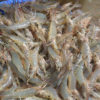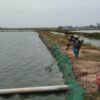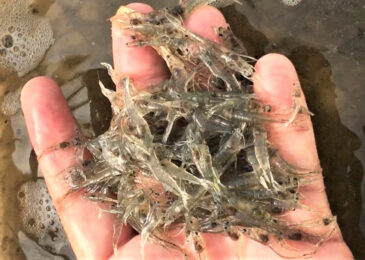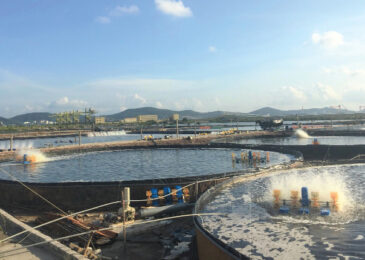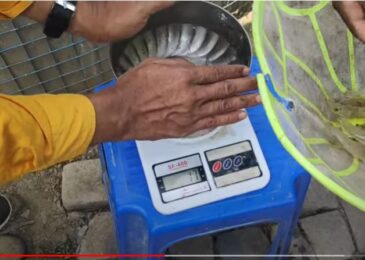In recent years, biofloc technology has been widely applied in our country. However, to achieve success, farmers need to comply with the principles of biofloc systems in their shrimp farming activities
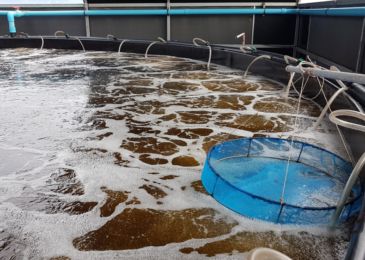
Construction of tanks or ponds
According to Khoo Eng Wah, CEO of Sepang Today Aquaculture Center (STAC) in Malaysia: For those who are new to biofloc application, it is best to start with a canvas pond, concrete pond or tank. In-house soil does not affect water parameters or biofloc process. In most tropical countries, the indoor system has an advantage over the outdoors, especially when undergoing a heavy rain that causes alkalinity and pH to change abruptly. Covered ponds are a good choice.
Aeration
Biofloc requires constant movement to maintain high oxygen levels and to keep solids from settling down. Areas without motion will quickly lose oxygen and turn into anaerobic areas that release large amounts of ammonia (NH3) and methane (CH4). To prevent this, in each pond, the aerators must be arranged appropriately. Ponds often use paddle wheel aerators (paddlewheel aerators). Biofloc systems require up to 6 mg of oxygen per liter per hour and should start with an aerator with a capacity of at least 30 hp / ha. But, depending on the intensity and productivity of the system, this number can reach 200 hp / ha. Aerators should be properly installed to create a flow in the pond. It is necessary to regularly move some aerators to ensure solid particles will not settle in areas with little or no flow.
Cultivating beneficial bacteria
To promote the development of biofloc systems and stabilize ponds faster, beneficial cultures should be cultivated before stocking shrimp. This can be done by adding some commercial microbial strains or self-made formulas to the culture water. A simple homemade recipe to quickly produce bio-bacteria and prebiotic is to use rice bran and Red Cap 48 (a local product from Southeast Asia) mixed in a sealed container and fermented in 48 hours, then the mixture can be added to the pond.
Stocking density
Thanks to strong aeration and self-filtering ability of culture water, high stocking density can be considered and usually stocking shrimp at a density of 150 to 250 PL / m2.
Balance input carbon source
Only carbon and nitrogen food mixtures (C / N)> 10 should be selected. Currently most fish and shrimp feeds have a C / N ratio of 9: 1 or 10: 1, so more inputs are needed to increase this ratio from 12: 1 to 15: 1. Can be used: molasses, cassava starch, sugarcane or starch.
Biofloc growth
With adequate aeration, natural light (in most systems) and available carbon resources, the amount of biofloc will begin to multiply rapidly. Depending on various factors, including water temperature, nutrients and sunlight, plus the number of bioflocs seeded at the beginning, the number of flocs will increase from nearly 0 to about 4-5 taste / mm in a few weeks. Finally, an incredible density of up to 10 billion bacteria per cm3.
Monitoring the growth of these flocs can be done by using conical cups to collect some water samples at a depth of 15 to 25 cm, preferably in the morning. Solid particles should be left for 20 minutes.
Monitor and control biofloc development
From this point on, water samples must be taken regularly to monitor and determine the activity of two biofloc types plus their corresponding density. Simply put, outdoor bioflocs include green algae and bacteria: algae mainly use sunlight to grow, while bacteria mainly eat leftovers, byproducts and related waste.
Environmental monitoring and control
When the biofloc system turns brown, aeration must be significantly increased to maintain a high respiratory rate. The rate of respiration at this stage can reach 6 mg / liter per hour, which requires six times more energy per hectare than when it started. It is important for the aeration system to always be active. A large diesel generator, including a second set of backup generators, may be the best choice for most large farm operations.
Tracking parameters
In addition to maintaining water quality at lower costs and without water exchange, the second goal of biofloc systems is to improve growth and raising efficiency, thereby improving profitability and sustainability. of farming activities.
To test how the farm is operating, it is necessary to regularly monitor farm performance factors, calculate and record growth rates, overall appearance, FCR and survival rates are required.
Cleaning
Cleaning ponds after harvest is often forgotten and underestimated, but this is very important. Although reusing water for breeding seems attractive because it takes a lot of effort to build microbial populations, but this is not recommended. Pathogens may have developed and may pose a serious biosecurity risk. The study also shows that over time, heavy metals can accumulate in cultured water, which can accumulate in ponds by making it unsuitable for human consumption. So, clean the system well before starting the next crop.

